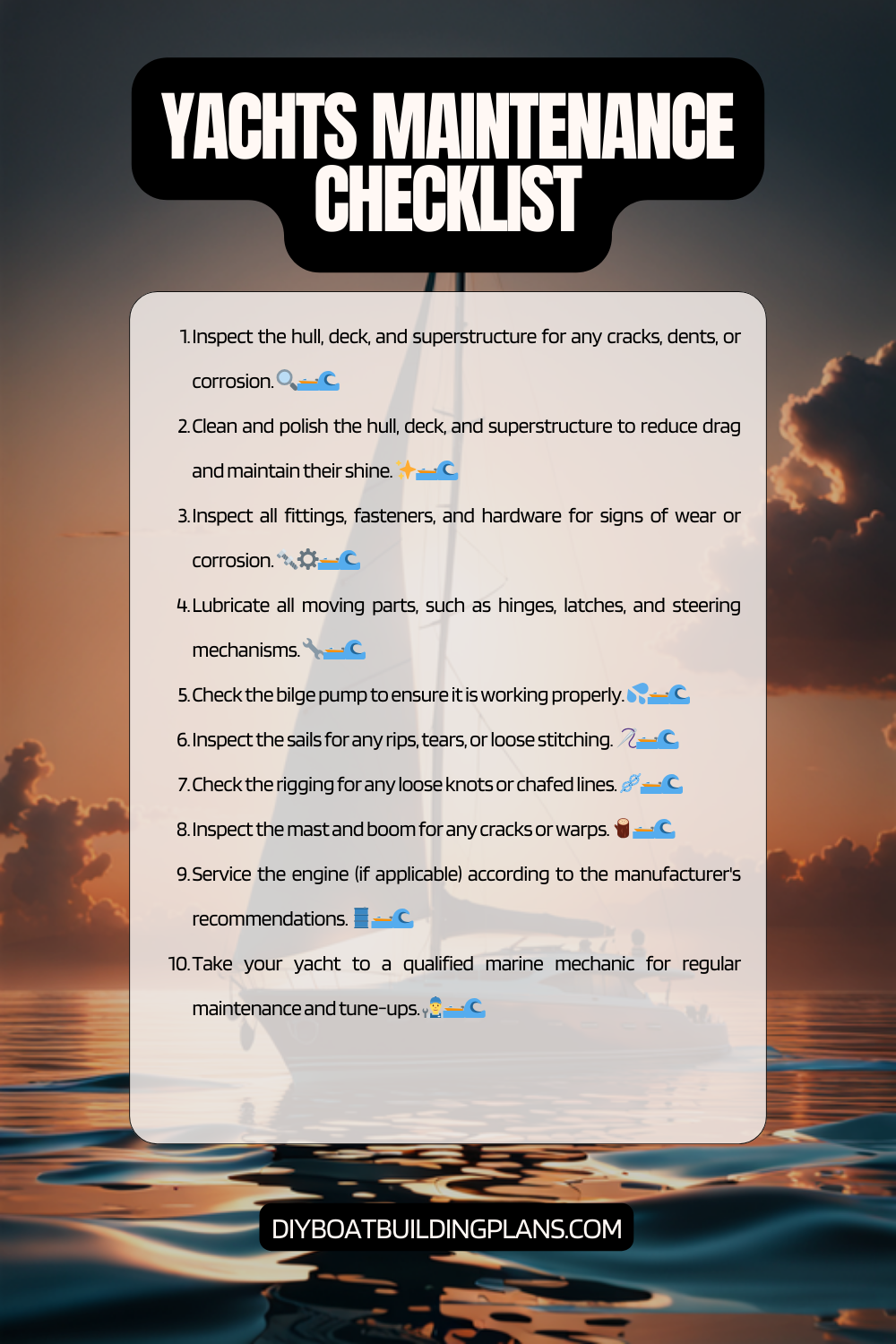Overview of Yacht Maintenance Tips
Yacht maintenance is an essential aspect of owning a yacht. It involves regular upkeep and care to ensure that the yacht remains in optimal condition. From cleaning and detailing to engine and mechanical maintenance, there are various aspects to consider when it comes to maintaining a yacht. Neglecting maintenance can lead to costly repairs and even compromise the safety of the vessel. Therefore, it is crucial for yacht owners to understand the importance of regular maintenance and invest time and effort into keeping their yachts in top shape.
Key Takeaways
- Regular yacht maintenance is crucial for ensuring the safety and longevity of your vessel.
- Essential tools and equipment for yacht maintenance include a pressure washer, marine-grade cleaning products, and a multimeter.
- Yacht cleaning and detailing tips include using a soft-bristled brush for scrubbing, avoiding harsh chemicals, and regularly waxing the hull.
- Engine and mechanical maintenance for yachts should include regular oil changes, checking belts and hoses, and inspecting the propeller.
- Safety and emergency equipment maintenance for yachts should include checking and replacing fire extinguishers, life jackets, and flares on a regular basis.

Importance of Regular Yacht Maintenance
Regular maintenance is vital for the longevity and performance of a yacht. By conducting routine checks and addressing any issues promptly, yacht owners can prevent minor problems from escalating into major ones. Regular maintenance also helps in identifying potential issues before they become serious, saving both time and money in the long run.
Neglecting maintenance can have severe consequences. For instance, failing to clean and detail a yacht regularly can result in the accumulation of dirt, grime, and salt deposits, which can damage the exterior finish and lead to corrosion. Similarly, neglecting engine maintenance can cause mechanical failures, reduced fuel efficiency, and even breakdowns at sea. Ignoring electrical system maintenance can result in electrical malfunctions or even fires. Therefore, regular maintenance is not just about aesthetics but also about ensuring the safety and reliability of the yacht.
Essential Yacht Maintenance Tools and Equipment
To effectively maintain a yacht, it is essential to have the right tools and equipment. Some of the necessary tools include a pressure washer for cleaning the exterior, soft-bristle brushes for scrubbing, microfiber cloths for drying, and various cleaning agents suitable for different surfaces.
In addition to cleaning tools, it is crucial to have a well-stocked toolbox with basic hand tools such as wrenches, screwdrivers, pliers, and electrical testers. These tools will come in handy for minor repairs and maintenance tasks. It is also advisable to have spare parts and lubricants specific to the yacht’s make and model.
Having the right tools not only makes maintenance tasks easier but also ensures that they are done correctly. Using improper tools can lead to damage or ineffective repairs, which can be costly to rectify. Therefore, investing in quality tools and equipment is a wise decision for any yacht owner.
Yacht Cleaning and Detailing Tips
| Yacht Cleaning and Detailing Tips | Description |
| 1. Use the right cleaning products | Choose products that are specifically designed for marine use and won’t harm the boat’s surfaces. |
| 2. Clean from top to bottom | Start at the top of the yacht and work your way down to avoid dirtying areas that have already been cleaned. |
| 3. Don’t forget the canvas | Canvas covers and bimini tops need to be cleaned and protected to prevent mold and mildew growth. |
| 4. Use a pressure washer with caution | Pressure washers can damage delicate surfaces, so use them with care and at a safe distance. |
| 5. Wax regularly | Waxing your yacht regularly will protect the gelcoat and keep it looking shiny and new. |
| 6. Clean the bilge | The bilge can harbor dirt, oil, and other contaminants, so it’s important to clean it regularly to prevent odors and damage. |
| 7. Don’t forget the interior | The interior of your yacht needs regular cleaning and maintenance to keep it looking and smelling fresh. |
| 8. Use a professional detailing service | A professional yacht detailing service can provide a deep clean and protect your yacht’s surfaces from damage. |
Cleaning and detailing a yacht is an essential part of maintenance. It not only keeps the yacht looking pristine but also helps in preventing damage caused by dirt, salt, and other environmental factors. Here are some steps to follow when cleaning and detailing a yacht:
1. Start by rinsing the exterior with fresh water to remove loose dirt and salt deposits.
2. Use a mild detergent or specialized boat cleaner to scrub the hull, deck, and other surfaces.
3. Pay attention to hard-to-reach areas such as corners, crevices, and fittings.
4. Rinse thoroughly with fresh water to remove all traces of soap or cleaner.
5. Dry the yacht using a soft cloth or chamois to prevent water spots.
6. Apply a protective wax or polish to the exterior surfaces to enhance shine and provide a barrier against UV rays and saltwater.
When it comes to cleaning products, it is essential to choose those specifically designed for marine use. These products are formulated to be safe for the yacht’s surfaces while effectively removing dirt and grime. Avoid using harsh chemicals or abrasive cleaners that can damage the finish or gel coat.
Engine and Mechanical Maintenance for Yachts
Proper engine and mechanical maintenance are crucial for the smooth operation of a yacht. Regular maintenance helps in identifying potential issues before they cause major breakdowns or failures. Here are some steps for maintaining the engine and other mechanical components:
1. Follow the manufacturer’s recommended maintenance schedule for oil changes, filter replacements, and other routine tasks.
2. Check the engine’s fluid levels regularly, including oil, coolant, and hydraulic fluids.
3. Inspect belts, hoses, and cables for signs of wear or damage and replace as necessary.
4. Clean and inspect the fuel system, including filters and injectors, to ensure proper fuel flow.
5. Lubricate moving parts such as hinges, bearings, and throttle linkages to prevent friction and corrosion.
6. Test the battery regularly and clean the terminals to ensure a reliable electrical connection.
Regular engine maintenance not only improves performance but also extends the engine’s lifespan. It also reduces the risk of unexpected breakdowns while out at sea, ensuring a safer and more enjoyable yachting experience.
Electrical System Maintenance for Yachts
The electrical system is a critical component of any yacht, powering various onboard systems such as lighting, navigation equipment, and communication devices. Proper electrical system maintenance is essential for safety and reliability. Here are some steps for maintaining the electrical system:
1. Regularly inspect wiring for signs of wear or damage and repair or replace as necessary.
2. Clean electrical connections to ensure a good contact and prevent corrosion.
3. Test batteries regularly and replace them when their performance declines.
4. Check fuses and circuit breakers to ensure they are functioning correctly.
5. Inspect and clean electrical panels to remove dust or debris that can interfere with proper operation.
It is crucial to follow proper safety procedures when working with the electrical system. If unsure about any maintenance tasks, it is advisable to consult a professional electrician or marine technician.
Plumbing and Water System Maintenance for Yachts
Maintaining the plumbing and water system of a yacht is essential for ensuring a reliable supply of fresh water and preventing leaks or other issues. Here are some steps for maintaining the plumbing and water system:
1. Regularly inspect hoses, fittings, and valves for leaks or signs of wear and replace as necessary.
2. Flush the water tanks regularly to remove any sediment or buildup.
3. Clean and disinfect the water tanks to prevent the growth of bacteria or algae.
4. Test the water pressure system and adjust as needed.
5. Inspect and clean filters and strainers to ensure proper water flow.
Regular maintenance of the plumbing and water system helps in preventing leaks, blockages, and other issues that can disrupt onboard comfort and functionality.
Sail and Rigging Maintenance for Yachts
For sailing yachts, proper sail and rigging maintenance is crucial for performance and safety. Neglecting maintenance can lead to sail damage, rigging failures, or compromised handling. Here are some steps for maintaining the sail and rigging:
1. Inspect sails regularly for signs of wear, tears, or UV damage and repair or replace as necessary.
2. Clean sails with mild detergent or specialized sail cleaner to remove dirt or salt deposits.
3. Inspect rigging components such as shrouds, stays, and turnbuckles for signs of corrosion or fatigue.
4. Lubricate moving parts such as winches, blocks, and furling systems to ensure smooth operation.
5. Check halyards and sheets for wear or fraying and replace as needed.
Proper sail and rigging maintenance not only ensures optimal performance but also enhances safety while sailing.
Hull Maintenance and Repair for Yachts
The hull is the foundation of a yacht, and proper maintenance is crucial for its integrity and performance. Neglecting hull maintenance can lead to structural damage, reduced fuel efficiency, or even sinking. Here are some steps for maintaining and repairing the hull:
1. Regularly inspect the hull for cracks, blisters, or other signs of damage and repair promptly.
2. Clean the hull regularly to remove dirt, algae, or barnacles that can affect performance.
3. Apply antifouling paint to prevent the growth of marine organisms and reduce drag.
4. Inspect and maintain through-hull fittings to ensure they are watertight.
5. Check the hull’s integrity, including bulkheads and stringers, for signs of damage or rot.
Proper hull maintenance and repair are essential for the safety and longevity of a yacht. It is advisable to consult a professional if unsure about any repairs or maintenance tasks.
Download over 500 Boat Plans. Click on the link below.
-->Click Here<--
Safety and Emergency Equipment Maintenance for Yachts
Maintaining safety and emergency equipment is crucial for the well-being of everyone onboard a yacht. Neglecting maintenance can render safety equipment ineffective when it is needed the most. Here are some steps for maintaining safety and emergency equipment:
1. Inspect life jackets, harnesses, and other personal flotation devices for signs of wear or damage and replace as necessary.
2. Test and recharge fire extinguishers according to manufacturer’s instructions.
3. Inspect and test the bilge pump regularly to ensure it is functioning correctly.
4. Check distress signals such as flares or EPIRBs (Emergency Position Indicating Radio Beacons) for expiration dates and replace as needed.
5. Inspect and maintain navigation lights to ensure they are visible and functioning correctly.
Regular maintenance of safety and emergency equipment helps in ensuring their reliability during critical situations.
Yacht Maintenance Checklist

Conclusion – Yacht Maintenance Tips
In conclusion, yacht maintenance is a crucial aspect of owning a yacht. Regular maintenance not only ensures the longevity and performance of the vessel but also enhances safety while out at sea. By following proper cleaning, engine, electrical, plumbing, sail, rigging, hull, and safety equipment maintenance practices, yacht owners can enjoy their vessels to the fullest while minimizing the risk of unexpected breakdowns or accidents.
To summarize the importance of yacht maintenance, it is essential to invest time and effort into regular upkeep. Neglecting maintenance can lead to costly repairs, compromised safety, and reduced enjoyment of the yacht. Therefore, it is advisable to follow manufacturer’s recommendations, use the right tools and equipment, and consult professionals when needed. By prioritizing maintenance, yacht owners can ensure that their vessels remain in optimal condition for years to come.
FAQs – Yacht Maintenance Tips
What is yacht maintenance?
Yacht maintenance refers to the regular upkeep and repair of a yacht to ensure its proper functioning and longevity.
Why is yacht maintenance important?
Yacht maintenance is important to ensure the safety of passengers and crew, prevent costly repairs, and maintain the value of the yacht.
What are some common yacht maintenance tasks?
Common yacht maintenance tasks include cleaning and polishing, checking and replacing fluids, inspecting and repairing electrical and mechanical systems, and maintaining the hull and deck.
How often should yacht maintenance be performed?
Yacht maintenance should be performed regularly, with some tasks being done daily or weekly, and others being done annually or every few years.
Can yacht maintenance be done by the owner?
Yes, many yacht maintenance tasks can be done by the owner, but some may require the expertise of a professional yacht maintenance company.
What are some tips for maintaining a yacht?
Some tips for maintaining a yacht include keeping it clean and dry, checking and replacing fluids regularly, inspecting and repairing systems as needed, and storing it properly when not in use.



